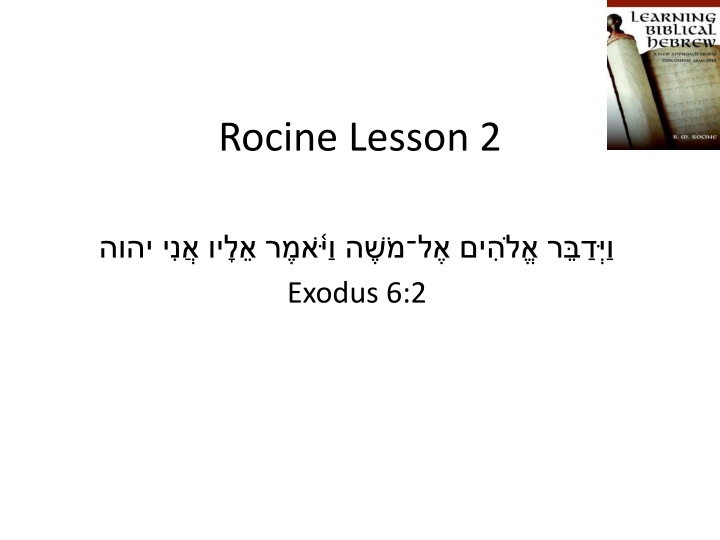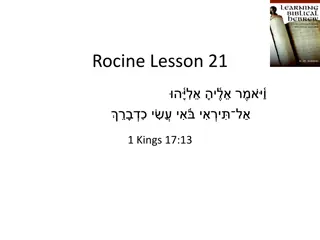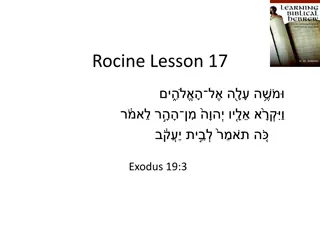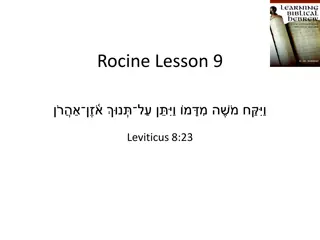
Learn Piel Stem in Lesson 2 of Rocine's Study on Exodus 6:2
Explore the Piel stem in Lesson 2 of Rocine's study on Exodus 6:2. Identify and read the Piel wayyiqtol 3rd masculine singular verb form, speaker, addressee, and verbless clause. Understand clauses, root meanings, and historical narratives in Hebrew.
Download Presentation

Please find below an Image/Link to download the presentation.
The content on the website is provided AS IS for your information and personal use only. It may not be sold, licensed, or shared on other websites without obtaining consent from the author. If you encounter any issues during the download, it is possible that the publisher has removed the file from their server.
You are allowed to download the files provided on this website for personal or commercial use, subject to the condition that they are used lawfully. All files are the property of their respective owners.
The content on the website is provided AS IS for your information and personal use only. It may not be sold, licensed, or shared on other websites without obtaining consent from the author.
E N D
Presentation Transcript
Rocine Lesson 2 Exodus 6:2
Goal Identify and read the Piel wayyiqtol 3rd masculine singular verb form Identify the speaker and addressee in speech Identify and read a verbless clause
Clauses A statement with SUBJECT and PREDICATE PREDICATE is often a verb but not always There are three clauses in the lesson verse. | |
Clauses A statement with SUBJECT and PREDICATE PREDICATE is often a verb but not always There are three clauses in the lesson verse. | |
Clauses A statement with SUBJECT and PREDICATE PREDICATE is often a verb but not always There are three clauses in the lesson verse. | |
Piel Piel is a stem (or binyan) In lesson 1 we saw the Qal stem
(From Lesson 1) Person, Gender, Number Root meaning Root Stem Form Function Historical Narrative Mainline Qal Wayyiqtol 3 m s say Stems are variations on the root. The Qal stem is the basic stem. It adds nothing. Let s see what is added to the root to form other stems.
(From Lesson 1) (From Lesson 2) Person, Gender, Number Root meaning Root Stem Form Function Historical Narrative Mainline Qal Wayyiqtol 3 m s Say Piel What is added to root in the Piel stem? (Note: if there is a vowel before a dagesh, it s a dagesh forte.)
(From Lesson 1) (From Lesson 2) Doubling of the middle root letter is the sign of the Piel. Person, Gender, Number Root meaning Root Stem Form Function Historical Narrative Mainline Qal Wayyiqtol 3 m s Say Piel What is added to root in the Piel stem? (Note: if there is a vowel before a dagesh, it s a dagesh forte.)
(From Lesson 1) (From Lesson 2) Person, Gender, Number Root meaning Root Stem Form Function Historical Narrative Mainline Qal Wayyiqtol 3 m s Say Piel 1. Do Rocine 2.2a (fill in blanks). 2. Compete the parsing chart above.
(From Lesson 1) (From Lesson 2) Person, Gender, Number Root meaning Root Stem Form Function Historical Narrative Mainline Qal Wayyiqtol 3 m s Say Historical Narrative Mainline Piel Wayyiqtol 3 m s Speak 1. Do Rocine 2.2a (fill in blanks). 2. Compete the parsing chart above.
(From Lesson 1) (From Lesson 2) Exeption in Piel Dagesh missing here. Person, Gender, Number Root meaning Root Stem Form Function Historical Narrative Mainline Qal Wayyiqtol 3 m s Say Historical Narrative Mainline Piel Wayyiqtol 3 m s Speak AN EXCEPTION. In the Piel forms with a yod prefix, the wayyiqtol dagesh will be missing. Coalmine rule.
Back to our verse - Subject | | can mean 1. God 2. gods
Subject | | can mean 1. God 2. gods Gen. 1:1 Ex. 20:3
Subject | | can mean 1. God 2. gods Gen. 1:1 Ex. 20:3 is the masculine plural ending 1. God = intensification or absolutization or exclusivity 2. Gods = true plural
On the plural form of God Yet its use in the OT for Israel s God (always with sing. vbs.) probably means that the pl. has reference to intensification or absolutization or exclusivity (say, God of gods); it is less commonly considered a pl. of majesty. While Trinitarian perspectives are probably not in view, the OT witnesses to a richness and complexity in the divine realm (Gen 1:26; Isa 6:8) such that later Trinitarian developments seem quite natural. Source ( NIDOTTE, 1:400.)
Subject | | can mean 1. God 2. gods 3. divine ones Gen. 1:1 Ex. 20:3 Psa. 8:6 ESV Psalm 8:5 Yet you have made him a little lower than the heavenly beings and crowned him with glory and honor. KJV Psalm 8:5 For thou hast made him a little lower than the angels, and hast crowned him with glory and honour. LXX Psalm 8:6 ESV Hebrews 2:7 You made him for a little while lower than the angels; you have crowned him with glory and
Addressee | | to, unto Can be used to indicate the addressee Who is the addressee in the first clause?
Addressee | | to, unto Can be used to indicate the addressee Who is the addressee in the first clause? In the second clause, the waw means him .
Do Rocine 2.5 (p. 9) Person, Gender, Number Root meaning Root Stem Form Function | |
Do Rocine 2.5 (p. 9) Person, Gender, Number Root meaning Root Stem Form Function Historical Narrative Mainline Qal Wayyiqtol 3 m s say | |
Do Rocine 2.5 (p. 9) Person, Gender, Number Root meaning Root Stem Form Function Historical Narrative Mainline Qal Wayyiqtol 3 m s say | | What stem (binyan) is the first verb?
Direct Speech | | No quotation marks Introduced by verbs of speaking (often 2) Direct speech common in HB
The Verbless Clause | | No verb here There is a predicate (the bit that tells us something about the subject) but it s not a verb English requires that we add the to be verb. e.g. I am YHWH
The Verbless Clause | | RULE: The verbless clause gives scene-setting information in Historical Narrative. it labels or describes rather than moves forward the plot of a story
The Verbless Clause | | RULE: The verbless clause gives scene-setting information in Historical Narrative. RULE: Standard word order for a verbless clause is S-P. Any deviation from this standard word order will move some element to the first position in the clause, thereby creating a focus on the fronted element.
The Verbless Clause | | RULE: The verbless clause gives scene-setting information in Historical Narrative. RULE: Standard word order for a verbless clause is S-P. Any deviation from this standard word order will move some element to the first position in the clause, thereby creating a focus on the fronted element. Subject is the existing Topic. Predicate is the new information, or Comment, about the subject.
The Verbless Clause | | RULE: The verbless clause gives scene-setting information in Historical Narrative. RULE: Standard word order for a verbless clause is S-P. Any deviation from this standard word order will move some element to the first position in the clause, thereby creating a focus on the fronted element. A subject pronoun is always the subject. E.g. = I; = you (ms); = they (masc or fem)



